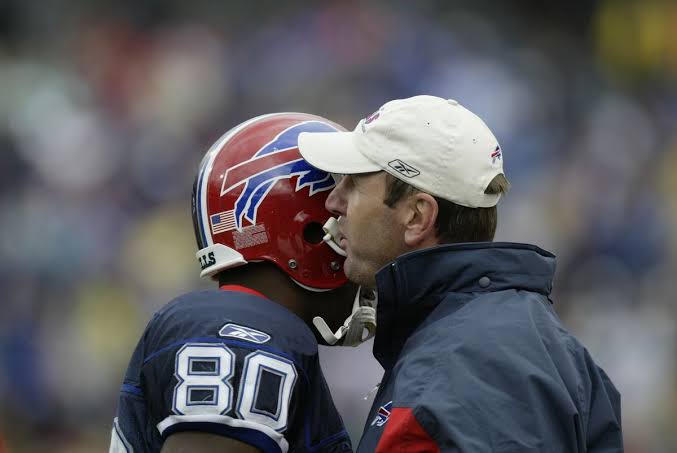During the 2023 NFL season and continuing now, Bills Mafia frequently expressed the opinion that Buffalo Bills head coach Sean McDermott should be dismissed. By whom? Many others don’t appear to care, believing that Josh Allen is a generational talent who provides a “easy button” for a head coach.
That made me think. What if we put Josh Allen on the underachieving Bills teams of the past?

What if… Josh Allen Quarterbacked the 2004 Buffalo Bills?
Overview
Following the departure of Gregg Williams, the Buffalo Bills hired a young offensive hotshot coordinator from the Pittsburgh Steelers going by the name “Mike Mularkey.” Because that was his name. It likely still is. This infamous Buffalo squad went 9-7, and faced a “win-and-in” contest against the Pittsburgh Steelers to end the season. They lost. To backups. The one-seed Steelers were resting pretty much everyone. A win would have tied the New York Jets’ overall record and thanks to a split division record, forced a common opponent tiebreaker with Pittsburgh a common opponent and sealing the deal.
Coaches and Stats
Mularkey kept many things the same for Buffalo, including retaining defensive coordinator Jerry Gray from Williams’ staff. The team remained a 4-3 scheme on defense with an Erhardt-Perkins scheme on offense. Mularkey brought in Tom Clements for offensive coordinator.
Despite an offensive-minded head coach, Buffalo’s offense only averaged 1.73 points per drive — 13th in the league. They held the same position in drives ending with a score, at 32.1%. Turning over the ball on 14.4% of drives, Buffalo was 18th in the league in that measure. This was mostly an interception problem with the ball lost 17 times that way and 12 due to fumble.
The defense was fifth-best in preventing points, allowing 1.37 points per drive. They allowed scores on 27.3% of drives — 12th in the league. Buffalo was incredible taking the ball away with the third-best rate in the league. The Bills had a take-away on 19.3% of drives. Buffalo generated plenty of pressure. The team was fourth in total sacks with 45, and third best in rate.
Between defense and special teams, Buffalo had a preposterously high 10 touchdowns. Four interception returns, three kickoff returns, two punt returns, and one blocked punt.
Supporting Cast
This was Drew Bledsoe’s final year in Buffalo before moving on to the Dallas Cowboys. I mention the Cowboys as Bledsoe’s first season there showed that his 2004 season in Buffalo was not up to his capabilities. It was overall fine as far as years go but had room for improvement.
At running back, Willis McGahee made his debut and was fine. He was backed up by Travis Henry who was also fine. The biggest name on the offensive line helping the running (and passing) game along was Mike Williams.
For the receiving threats, Buffalo focused on two targets just like I’m about to here. Eric Moulds and Lee Evans. The latter of the two was in his rookie season but shone brightly in his debut season. Despite higher targets for Moulds, Evans had the better touchdown, catch rate, and yards-per-target numbers. To be clear, I’m not suggesting Moulds had a bad year.
The defense had enviable talent in 2004. Looking at the names on the list, the numbers above are no surprise. On the defensive line Sam Adams (Pro Bowl), Pat Williams (TD on interception), Chris Kelsay, and Aaron Schobel made up a heck of a starting unit.
The linebackers featured both Takeo Spikes and London Fletcher. Spikes had an All-Pro season that year. Terence McGee and Nate Clements made the Pro Bowl from the defensive backfield at corner. Lawyer Milloy did not, but his numbers suggest maybe he should have.
The Josh Allen Effect
I’ll start with my idea of “defensive ripple” first. It’s unlikely Allen has any noticeable effect on the defense throughout the year. That unit was already playing at a very high level, dare I say “elite.” In addition, Buffalo had good time-of-possession numbers. There may have been some effect in individual games, but the aggregate shouldn’t change a whole lot.
Buffalo’s big issues on offense were the lack of star power after the tandem of Moulds and Evans. That’s not to say everyone else dragged the team down, but that duo is a tough act to follow. This extended to the running back room with a pair of backs who were, as noted, “fine.”
Be the first to comment